 zachary harden
zachary harden
Keywords: cross of lorraine | oak leaves | magyar | tolna | torda |
Links: FOTW homepage | search | disclaimer and copyright | write us | mirrors

Last modified: 2023-06-03 by  zachary harden
zachary harden
Keywords: cross of lorraine | oak leaves | magyar | tolna | torda |
Links: FOTW homepage |
search |
disclaimer and copyright |
write us |
mirrors
See also:
Other sites of 1848 Flags:
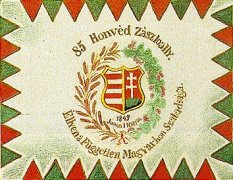
image from <w3.swi.hu>,
located by István Molnár, 16 July 2000
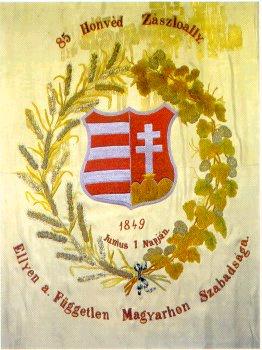
image by István Molnár, 19 June 2001
I don't know if this flag was used. This is a flag of the
Independece War 1848-1849.
"85 Honvéd Zászlóally" means "85th Battalion of
the Hungarian Army"
"Éllyen a Független Magyarhon Szabadsága" means
"Live the Freedom of the Independent Hungary"
István Molnár, 16 July 2000
Description From 'National Relics - A History of the War
Banners of the Hungarian: Revolution and War of Independence
1848-1849. Atlantic Studies on Society in Change No. 115.':
"FRAGMENT OF THE BANNER OF THE 85TH HONVÉD BATTALION
The fragmented central parts of the front sheet of the banner. In
the middle of the fragment there is the Baroque smaller coat of
arms (the so-called Kossuth arms) without the crown and under it
an inscription '1849/Junius 1 Napján' (on 1 June, 1849). The
coat of arms and the inscription are bordered by a wreath of
wheat ears and bunches of grapes held together by a bow of blue
ribbon. The inscription above the wreath reads '85 Honvéd
Zászlóally' (85th honvéd battalion) and the one under it reads
'Éllyen a Független Magyarhon Szabadsága' (Long live the
liberty of independent Hungary), embroidered in red. As indicated
by its symbols, the banner must have belonged to an agricultural
associationand must have been transformed into a honvéd war
banner by the lady donating it. It was consecrated on June 1,
1849. After the suppression of the war of independence the banner
was saved an preserved by Gábor Kocsis, a Szekler from
Árokfalva. It was donated to the National Museum by the
Rikánbeloli Honvéd Egyesület in 1894. From there it got into
the possesion of the War Museum in 1936. Made presumably by Mrs.
Rafael Benko, née Rozália Lázár in 1849. A single-sheet silk
ripp embroidered with silk thread and purl, decorated with
pressed and gilded silver lamellas. Size: 124 by 74 centimetres
Inventory number: HTM 39/ZI"
This picture is a well reconstruction of the original flag...
István Molnár, 18 June 2001
See also: <mek.oszk.hu>
Here is a photo of the Home
Guard of Komárom County (1848).
István Molnár, 24 January 2002
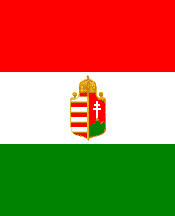
image by István Molnár, 11 June 2001
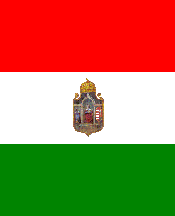
Reverse side
image by István Molnár, 11 June 2001
tm848.gif)
Coat of Arms on the reverse side
image by István Molnár, 11 June 2001
The images are based on the photo of the flag. Description
from 'National Relics - A History of the War Banners of the
Hungarian Revolution and War of Independence 1848-1849. Atlantic
Studies on Society in Change No. 115.':
"BANNER OF THE MOUNTED NATIONAL GUARD OF TOLNA COUNTY
A Hungarian tricolour. In the white stripe on its front the
Hungarian arms is painted into a small pointed shield. Above the
curved upper end of the shield there is the Hungarian crown. On
the back the arms of Tolna County is displayed irt the same
manner. In 1849 the banner was seized by the Russians at
Világos. In 1941 it was returned to Hungary. It got to the
Military History Museum following its second return in 1948.
Restored by Mrs. Áipli, née Mária Faragó in 1998.
A single-sheet banner made in 1848 frorn silk ripp, with paínted
decoration. Size: 105 by 95 centimetres Inventory number: HTM
23/ZI"
István Molnár, 11 June 2001
Here is a photo of the flag
and a photo of the detail
taken by me at the Museum of the Hungarian Military History.
István Molnár, 26 March 2006
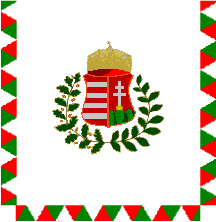
image by István Molnár, 22 June 2001
Description From 'National Relics - A History of the War
Banners of the Hungarian Revolution and War of Independence
1848-1849. Atlantic Studies on Society in Change No. 115.'
"BANNER OF THE NATIONAL GUARD UNIT OF TORDA COUNTY - A
double-sheet banner made in 1848 from silk, embroidered and
painted. Size 94/89 centimetres. Inventary number: 22/ZI. On its front side there is an
embroiered blazon with the crown and the traditional
Baroque-style shield bordered by a wreath of olive branches. In
the right field there are four silver fesses. The reverse side displays the
arms of Torda County. The three free edges are bordered with
triangles facing each other in the national colours. The banner
is unusally suspended, the axis of the escutheon forming a right
angle to the staff. It was probably used either by the 11th
Székely (Szekler) or by the 15th Mátyás (Matthias) huszár
(cavalry) regiment. According to the Russian records it was
seized by the Russian troops at Világos from Bem's army corps.
It was returned to Hungary first in 1941. In 1948 it got to the
Military History Museum. Restored by Márta Tóth in 1998."
Világos is now Siria (Arad county, Romania). Torda county is one
of the oldest Hungarian counties. It was devided into two parts
in 1886. The eastern part was united with Maros-szék (Maros
county of the Székely Land), - now Mures county of Romania. The
western part was united with Aranyos-szék (Aranyos county of the
Székely Land), now in Cluj and Alba counties of Romania.)
István Molnár, 22 June 2001
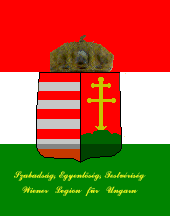
image by István Molnár, 6 June 2001
The image is based on the photo
of the flag. The original flag is a tricolour with painted
Coat of Arms. Description From 'National Relics - A History of
the War Banners of the Hungarian: Revolution and War of
Independence 1848-1849. Atlantic Studies on Society in Change No.
115.':
"The Banner of the Viennese Legion - A one-sheet banner made
in 1848 from silk damask, with painted images. Size 155 by 122
centimetres. Inventary number HTM 24/Zl - On the front of the
red, white, and green banner there is the Hungarian arms with the
crown and four silver fesses in its right field. An inscription
is painted in gold under the escutcheon saying 'Szabadság,
Egyenlőség, Testvériség' (Liberty, Wquality, Fraternity).
Below this one is another also in gold: 'Wiener Legion für
Ungarn'. The reverse side is identical with the front. There were
several units fighting in the war of independence under the name
Bécsi-Wiener Legion, it is therefore impossible to tell which of
them used this particular banner. It was seized by the Russians
at Világos, was restored to Hungary in 1941 for the first time
and in 1948 for the second time when it got to the Military
History Museum. Restored by Mrs. Laki, Ilona Tóth in 1997."
(Világos, Arad county now Siria, Arad county, Romania)
István Molnár, 6 June 2001
Here is another photo of
the flag taken by me at the Museum of the Hungarian Military
History.
István Molnár, 17 March 2006
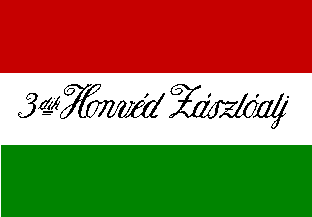
3rd Honvéd Battalion (1848)
image by István Molnár, 16 January 2006
Here is the translation from <www.sulinet.hu>,
located by Dov Gutterman, 24 January 1999:
"Our Escaped FlagsThe War History Museum guards flags
remaining from the 1848-49 Revolution and War of Liberation. Each
has its own history. Here's a sampler:
The
Hunyadi Volunteer Corps' Flag
After the victory of the Revolution of 1848, the Hungarian
Parliament passed a resolution bringing back, in its
"ancient right" the country's coat-of-arms and national
colours. Later, these -methodically combined with the counties'
CoA- appeared on the flags of the National Guard, which had been
in preparation since March with great speed. The population of
each county prepared and donated the flags of that county's
National Guard. To standardize all the different flags, the
Parliament passed a decree, though it did not meet with much
success.
The
Regular Flag of an Unidentified Corps
The real strength of the 1848-49 War of Liberation was not the
National Guard, but rather the specialized and enthusiastic
Hungarian Army, whose first two batallions were drafted in the
capital city (Buda). The gigantic parade for the flag-blessing
took place on June 24 1848, in Pest, in Újpiac Square (now
Erzsébet Square). The flag, which the contemporary press
enthusiastically wrote about, saying "finally, the first
Hungarian flag par excellence is born", became the Hungarian
Army's flags' standard of measure. about its origins, -since it
was not regulated by a decree, at least not as far as the
archivists have discovered- we know little. It was probably
prepared in Óbuda. Tradition holds József Knopp as the standard
painter of "Madonna-ic" flags. The young artist from
Óbuda studied in Munich and Vienna, and upon hearing of the
revolution, returned to the capital (Buda). The regiment's
commander, György Lázár, probably entrusted him with the
preparation of the flag. The flags are formed in the Hungarian
tradition, but their origins can be traced to the empire's flags.
The Ministry of Defence declared these flags as "prepared
according to regulations" and distributed one to each corps.
Many corps, mainly the 3rd,
4th and 5th Batallions stuck to their unregulated flags, and that
is why some corps have two banners.
Company Flag - Decoration
The first "standard" flag had an interesting fate. In
the battle of Komárom (Komarno) on Jul.14 1849, an Austrian
soldier ripped it out of the standard-bearer's hands, and during
the ensuing scuffle, one of its corners was ripped off. The loss
of the flag - an incident of great shame in the eyes of the
batallion - meant its recapture. The Austrian commander, however,
contrary to orders, only burned the staff and the decorative
ribbon, received from the flag's seamstress, Mrs. Lajos
Batthyány, at the nightly campfire. The banner itself was
guarded by the Austrian family, and in 1930 was purchased from
the grandson for the sum of 1,500 pengő". The flag, however,
still haden't played out its fate entirely: in 1945, it ended up
in the hands of the Red Army, and was only returned from
'internment' in 1948."
There is also the flag of the
3rd Honvéd Battalion
Georges Kovari III, 25 January 1999 and István
Molnár, 18 June 2001
Here are photos of flags from 1848-49 that I took during my visit at the Museum of the Hungarian Military History:
István Molnár, 17 and 26 March 2006
There is a flag
depicting the Hungarian Legion in Italy. I have a photo/copy of a
Hungarian Legion flag during the same period, yet the flag is
different. The flag I found is shown at the Royal
Armory in Turin. I know that the Hungarian Legion was 5
000 strong, but do not know if there were more flags.
Edward, 5 June 2009